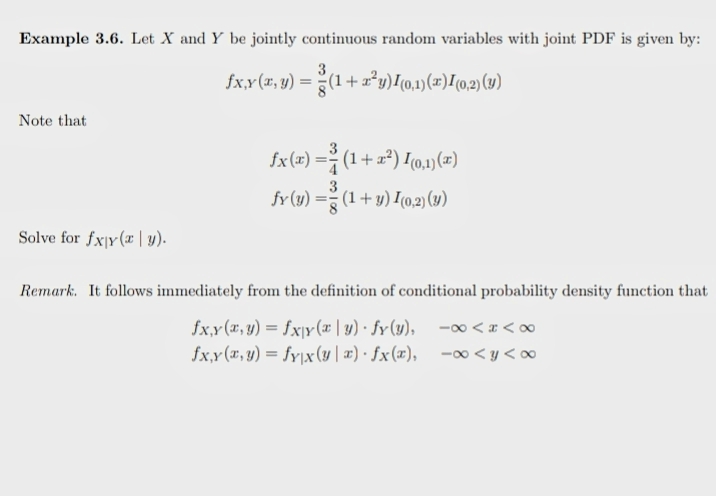Example 3.6. Let X and Y be jointly continuous random variables with joint PDF is given by: Note that fx(x) =÷(1+ x²) I0,1)(7) 3 fr (y) =÷ (1 + y) I0,2)(y) Solve for fxjr(r | y). Remark. It follows immediately from the definition of conditional probability density function that fx,y(r, y) = fxjy(x | y) · fy (y), -0 < # < 0 fxy(x, y) = fyjx(y| a) fx(x), -00 < y
Example 3.6. Let X and Y be jointly continuous random variables with joint PDF is given by: Note that fx(x) =÷(1+ x²) I0,1)(7) 3 fr (y) =÷ (1 + y) I0,2)(y) Solve for fxjr(r | y). Remark. It follows immediately from the definition of conditional probability density function that fx,y(r, y) = fxjy(x | y) · fy (y), -0 < # < 0 fxy(x, y) = fyjx(y| a) fx(x), -00 < y
Linear Algebra: A Modern Introduction
4th Edition
ISBN:9781285463247
Author:David Poole
Publisher:David Poole
Chapter4: Eigenvalues And Eigenvectors
Section4.6: Applications And The Perron-frobenius Theorem
Problem 70EQ
Related questions
Question

Transcribed Image Text:Example 3.6. Let X and Y be jointly continuous random variables with joint PDF is given by:
3
fx,x(r, y) = (1 + a°y)[(0,1)(=)[(0,2) (1)
Note that
fx(x) =÷ (1 + a²) I0,1)(x)
fr(y) =-
(1+y) I(0,2) (y)
Solve for fxjy(æ | y).
Remark. It follows immediately from the definition of conditional probability density function that
fx,x(x, y) = fxjy(x | y) · fy(y), -o∞ < x < ∞
fx,y (x, y) = fy|x(y | æ) · fx(x), - <y <o∞
Expert Solution
This question has been solved!
Explore an expertly crafted, step-by-step solution for a thorough understanding of key concepts.
Step by step
Solved in 2 steps with 1 images

Recommended textbooks for you

Linear Algebra: A Modern Introduction
Algebra
ISBN:
9781285463247
Author:
David Poole
Publisher:
Cengage Learning

Trigonometry (MindTap Course List)
Trigonometry
ISBN:
9781337278461
Author:
Ron Larson
Publisher:
Cengage Learning

Linear Algebra: A Modern Introduction
Algebra
ISBN:
9781285463247
Author:
David Poole
Publisher:
Cengage Learning

Trigonometry (MindTap Course List)
Trigonometry
ISBN:
9781337278461
Author:
Ron Larson
Publisher:
Cengage Learning